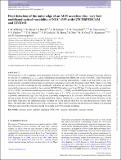Files in this item
First detection of the outer edge of an AGN accretion disc : very fast multiband optical variability of NGC 4395 with GTC/HiPERCAM and LT/IO:O
Item metadata
| dc.contributor.author | Mc Hardy, I M | |
| dc.contributor.author | Beard, M | |
| dc.contributor.author | Breedt, E | |
| dc.contributor.author | Knapen, J H | |
| dc.contributor.author | Vincentelli, F M | |
| dc.contributor.author | Veresvarska, M | |
| dc.contributor.author | Dhillon, V S | |
| dc.contributor.author | Marsh, T R | |
| dc.contributor.author | Littlefair, S P | |
| dc.contributor.author | Horne, K | |
| dc.contributor.author | Glew, R | |
| dc.contributor.author | Goad, M R | |
| dc.contributor.author | Kammoun, E | |
| dc.contributor.author | Emmanoulopoulos, D | |
| dc.date.accessioned | 2023-01-20T16:30:03Z | |
| dc.date.available | 2023-01-20T16:30:03Z | |
| dc.date.issued | 2023-03-01 | |
| dc.identifier | 283033741 | |
| dc.identifier | 53f09270-9148-44a7-9b7f-1bd39be40129 | |
| dc.identifier | 85159677013 | |
| dc.identifier.citation | Mc Hardy , I M , Beard , M , Breedt , E , Knapen , J H , Vincentelli , F M , Veresvarska , M , Dhillon , V S , Marsh , T R , Littlefair , S P , Horne , K , Glew , R , Goad , M R , Kammoun , E & Emmanoulopoulos , D 2023 , ' First detection of the outer edge of an AGN accretion disc : very fast multiband optical variability of NGC 4395 with GTC/HiPERCAM and LT/IO:O ' , Monthly Notices of the Royal Astronomical Society , vol. 519 , no. 3 , stac3651 , pp. 3366–3382 . https://doi.org/10.1093/mnras/stac3651 | en |
| dc.identifier.issn | 0035-8711 | |
| dc.identifier.other | Jisc: 829072 | |
| dc.identifier.uri | https://hdl.handle.net/10023/26800 | |
| dc.description | Funding: The design and construction of HiPERCAM was funded by the European Research Council under the European Union’s Seventh Framework Programme (FP/2007-2013) under ERC-2013-ADG Grant Agreement No. 340040 (HiPERCAM). VSD and HiPERCAM operations are supported by grant ST/V000853/1 from the UK Science and Technology Facilities Council (STFC). IMcH and FMV thank STFC for support under grant ST/J001600/1 and EB thanks STFC for support under grantST/S000623/1. TRM thanked STFC for support under grant ST/T000406/1. MB and MV thank STFC for studentships under numbers ST/S505705/1 and ST/W507428/1, respectively. EK acknowledges financial support from the Centre National d’Etudes Spatiales (CNES). JHK acknowledges financial support from the State Research Agency (AEI-MCINN) of the Spanish Ministry of Science and Innovation under the grant ‘The structure and evolution of galaxies and their central regions’ with reference PID2019-105602GB-I00/10.13039/501100011033, from the ACIISI, Consejería de Economía, Conocimiento y Empleo del Gobierno de Canarias and the European Regional Development Fund (ERDF) under grant with reference PROID2021010044, and from IAC project P/300724, financed by the Ministry of Science and Innovation, through the State Budget and by the Canary Islands Department of Economy, Knowledge and Employment, through the Regional Budget of the Autonomous Community. | en |
| dc.description.abstract | We present fast (∼200 s sampling) ugriz photometry of the low -mass AGN NGC 4395 with the Liverpool Telescope, followed by very fast (3 s sampling) us, gs, rs, is, and zs simultaneous monitoring with HiPERCAM on the 10.4m GTC. These observations provide the fastest ever AGN multiband photometry and very precise lag measurements. Unlike in all other AGN, gs lags us by a large amount, consistent with disc reprocessing but not with reprocessing in the broad-line region (BLR). There is very little increase in lag with wavelength at long wavelengths, indicating an outer edge (Rout) to the reprocessor. We have compared truncated disc reprocessing models to the combined HiPERCAM and previous X-ray/UV lags. For the normally accepted mass of 3.6 × 105M⊙, we obtain reasonable agreement with zero spin, Rout ∼ 1700Rg and the DONE physically motivated temperature-dependent disc colour-correction factor (fcol). A smaller mass of 4 × 104M⊙ can only be accommodated if fcol=2.4, which is probably unrealistically high. Disc self gravity is probably unimportant in this low-mass AGN but an obscuring wind may provide an edge. For the small mass, the dust sublimation radius is similar to Rout so the wind could be dusty. However, for the more likely large mass, the sublimation radius is further out so the optically thick base of a line-driven gaseous wind is more likely. The inner edge of the BLR is close to Rout in both cases. These observations provide the first good evidence for a truncated AGN disc and caution that truncation should be included in reverberation lag modelling. | |
| dc.format.extent | 17 | |
| dc.format.extent | 4676764 | |
| dc.format.extent | 3779072 | |
| dc.language.iso | eng | |
| dc.relation.ispartof | Monthly Notices of the Royal Astronomical Society | en |
| dc.subject | Galaxies: active | en |
| dc.subject | Galaxies: individual: NGC 45395 | en |
| dc.subject | Galaxies: photometry | en |
| dc.subject | Galaxies: Seyfert | en |
| dc.subject | QB Astronomy | en |
| dc.subject | QC Physics | en |
| dc.subject | 3rd-DAS | en |
| dc.subject | MCC | en |
| dc.subject.lcc | QB | en |
| dc.subject.lcc | QC | en |
| dc.title | First detection of the outer edge of an AGN accretion disc : very fast multiband optical variability of NGC 4395 with GTC/HiPERCAM and LT/IO:O | en |
| dc.type | Journal article | en |
| dc.contributor.institution | University of St Andrews. School of Physics and Astronomy | en |
| dc.contributor.institution | University of St Andrews. St Andrews Centre for Exoplanet Science | en |
| dc.identifier.doi | https://doi.org/10.1093/mnras/stac3651 | |
| dc.description.status | Peer reviewed | en |
This item appears in the following Collection(s)
Items in the St Andrews Research Repository are protected by copyright, with all rights reserved, unless otherwise indicated.


